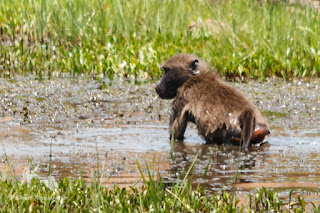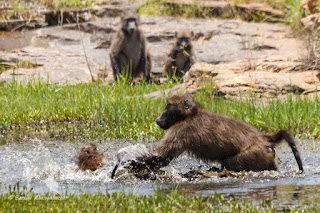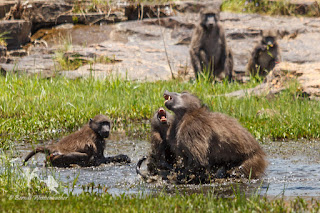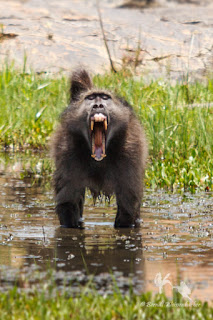REMINISCENCES: Why do Bullies Always Hog the Swimming Pool for Themselves?
As a four-year-old,
I came very close to drowning in a public swimming pool. It is no surprise then
that as a pre-teen I was always reticent to immerse myself in deep water, be it
in a swimming pool, a farm dam, a lake or a stretch of river. In my early teens,
I developed into a very strong swimmer and enjoyed the wild waters
tremendously. Nevertheless, public swimming baths still gave me the
heebie-jeebies. The reason for this apparent discrepancy was rooted firmly in
the inevitable presence at public pools of a few males intent on being noticed,
thereby disrupting the peace and pleasure of others. There are always bullies
at public swimming pools!
Jacqui and I
had decided to visit Suikerbosrand Nature Reserve (some 50 kilometres South of
Johannesburg, South Africa) for a half-day trip. We had spent a wonderful
morning exploring this little gem of a reserve. On our way back to the main
gate, we spotted a troop of chacma baboons foraging in some grassland flanking
one of the many hills that comprise Suikerbosrand. I always stop for baboon
troops – I can watch these mini-hominoids for hours on end, usually giggling
all the while at their concentrated, solemn miens interspersed suddenly with
comical antics.
As the morning
heated up, the troop moved towards a seep-line for a drink of water from
several runnels flowing between small boulders. A few youngsters discovered a
tiny pool of water. One of them decided to take a dip, probably attracted by
some luscious water plant stems. The troop soon decided to move on; only the
youngsters remained behind at the seep, relaxing on rock slabs or playing very
short games of ‘catch-me-if-you-can’.
A straggling
male arrived near the seep a few minutes later. With a typical male strut (like
gym-jocks, arms seemingly bent as though clutching watermelons under armpits),
he moved swiftly towards the knot of relaxing youngsters. With gusto, he
started chasing the youngsters off the rock slab. Next, he turned his attention
on the lone dipper. The large male leaped into the water and attacked the
bewildered youngster with ferocity. A young sympathiser tried to support his
chum from a safe distance, without influence on the conflict.
Is bullying
unique to our species? A number of scientists who study animal behaviour would
claim that the answer to this question is almost certainly “No”. After all, we
simply need to look at whether or not bullying is present in other species – a
simple enough task, it seems. Furthermore, most of us, if asked this question,
would answer that we personally have witnessed bullying behaviour in animals
such as dogs, lion prides, hyaena clans, troops of baboons and vervet monkeys,
for example.
Even a cursory
glance at the scientific literature on animal behaviour will show that a number
of ethologists claim that there is ample evidence that many animals other than
humans engage frequently in bullying-like behaviours. It has been reported that
bullies exist among rats and mice (usually studied in laboratories), a large
host of other social vertebrate species, including most other primates.
Among baboons,
bullying-like behaviours are claimed to be very common. It is alleged that
baboons use actual and threatened ‘violence’ to confirm their social status
within a troop and to increase their status if this is possible. The aim of the
aggression is to become the most dominant animal, or at least one of the high
ranking and more dominant individuals within the troop. Social dominance
confers first (or a better) choice of food, mates and other resources.
A baboon troop
is essentially a society of several females and their offspring living with
several males. The social status of the females is based on matrilines spanning
several generations. That is, all the female offspring of a dominant female
have high rank within the troop bestowed upon them by their kinship to the
dominant female. Inevitably, some matrilines
are more dominant than other kinship groups,
so that social bonds amongst the females can be quite complex. Competition over
limited resources can become severe within a baboon troop (during extended droughts,
for example). While it is certainly well documented that female baboons will
use aggression and intimidation to gain greater access to limited resources, we
need to keep in mind that the hostility usually never becomes so severe that the
society itself breaks apart. Moreover, the aim of the aggressive behaviour is
twofold: to gain greater access to resources and to reinforce the social
hierarchy.
The social
status of the males is more precarious than that of the females and is subject
to change. The rank of males depends very much on age and size; males dominate
everyone smaller than they are, regardless of their matrilineal rank. The
recipients of the fiercest aggression are the adolescent males in the troop. In
their endeavours to join the social milieu,
their attempts at any form of dominance behaviour are usually reciprocated with
hostility. Again, this ferocious behaviour towards the young males is not
aggression or intimidation for their own sake; rather, being related to their
mothers and sisters, these youngsters may not mate within the troop. The
ousting from any animal society of youngsters of either sex (or both in some
cases) serves to protect the society from the negative effects of inbreeding. Aggression
and intimidation towards individuals on the cusp of their sexual maturity,
behaviour aimed at individuals to force their departure from the society, is present
almost universally in animal societies; this belligerence is thus mostly a
consequence of heredity.
It is clear,
then, that to work out a definite answer to the question of whether bullying
behaviour exists in other animal species too is much more difficult to achieve
than many ethologists claim. Bullying behaviour is an act of intention. Intentions
are difficult to identify in other animals simply because we can not
communicate with them. We can not ask individuals of other species about their
intentions. It is often assumed in studies of animal behaviour that we do not
need to know the intentions of animal individuals when we are trying to
understand and interpret their behaviour; we just have to determine if the point
of a particular behaviour is to achieve a certain outcome as defined by the
human observer. For example, the aim of bullying would be to intimidate other
individuals (so it is claimed). If we can show that an individual animal that
is the perpetrator of bullying behaviour shows measurable signs of aggression
(defined by the observer), and the recipient, the target of the aggression
shows a measurable response to the intimidation (again defined by the
observer), then we have shown that bullying has indeed taken place.
Yet, without
knowing the intention, it is difficult to tell bullying apart from many other behaviours
that include aggression and intimidation. Good examples among non-adults
include rough play behaviour or mock fighting in adolescent animals. Is such
behaviour ‘bullying’, or is this ‘play behaviour’, this ‘training’ a learning
experience and necessary practice to develop physical strength and agility of
movement for forthcoming fights as an adult?
There are many
examples from the adult world of animal behaviour too. If a wild animal has
ever charged you, you will know that the charge is meant to intimidate you.
Similarly, individual animals will also threaten and displace others from a
food source such as a kill or a shrub with sweet fruits on it, for example.
Again, intimidation is used to achieve a particular goal – to ensure that the
threatening individual receives sufficient food. Another example involves the
holders of a territory, an area of exclusive use, from which they exclude other
individuals by using aggression and intimidation – this is done to secure a
scarce, defendable resource. Is the defence of a territory an example of
bullying behaviour? Are territorial animals bullies?
The behaviour
I witnessed in Suikerbosrand was clearly intimidation, plain and simple to see.
Levels of aggression were high and the youngster who was the sole focus of the
fierce intimidation by the older male attempted to defend itself with obvious submissive
gestures. When submission failed, the behaviour changed at certain times to aggression,
bared teeth, snarls, growls and howls.
And the
aggressor? He simply ended up standing in the centre of the little pool of
water. He did not drink, he did not munch on the juicy stems of water plants,
he just yawned, exposing his fearsome canines. This lack of measurable gain from
the use of all that aggression and spent energy gave rise to my suspicion that
I was witnessing one of the swimming pool bullies from my youth. It certainly looks
like I have not been the only primate youngster to have been bullied at a
public swimming pool.









No comments:
Post a Comment